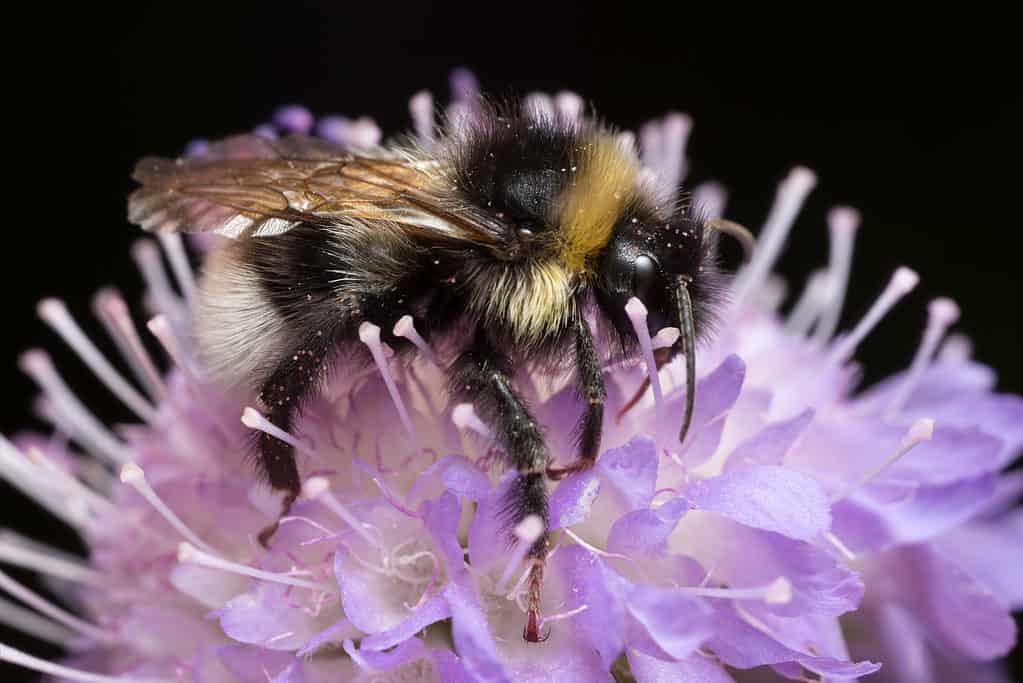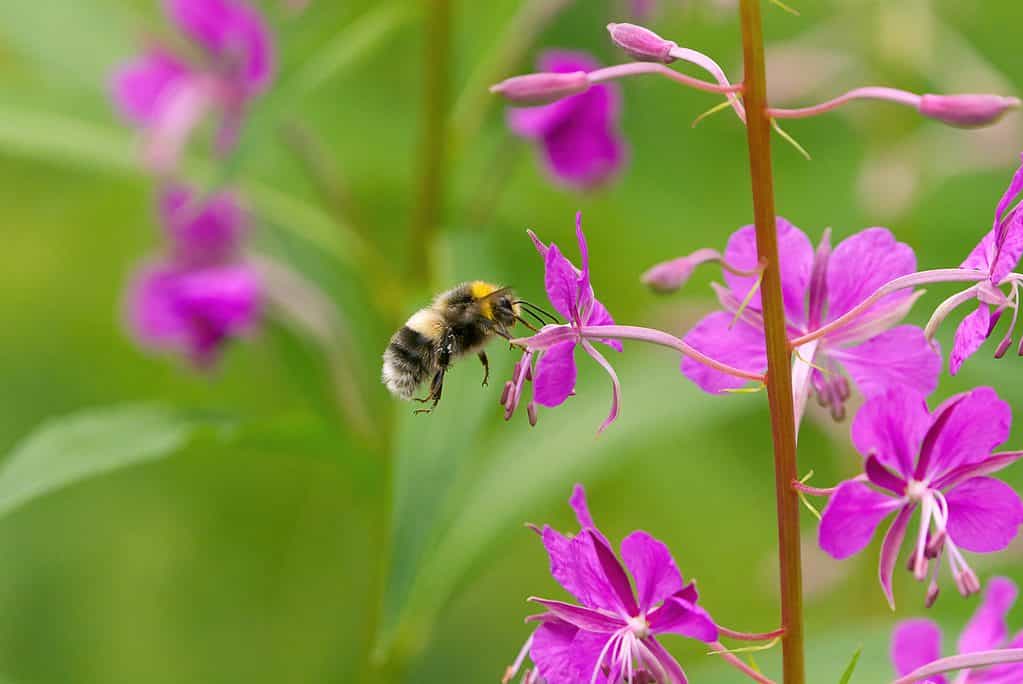Gypsy Cuckoo Bumblebee
Bombus bohemicus
Male gypsy cuckoo bumblebees do not have stingers!
Advertisement
Gypsy Cuckoo Bumblebee Scientific Classification
- Kingdom
- Animalia
- Phylum
- Arthropoda
- Class
- Insecta
- Order
- Hymenoptera
- Family
- Apidae
- Genus
- Bombus
- Scientific Name
- Bombus bohemicus
Read our Complete Guide to Classification of Animals.
Gypsy Cuckoo Bumblebee Conservation Status
Gypsy Cuckoo Bumblebee Facts
- Prey
- The common eastern bumble bee, (Bombus impatiens), the white-tailed bumblebee (Bombus locurum), and the cryptic bumblebee (Bombus cryptarum)
- Main Prey
- The buff-tailed bumblebee (Bombus terrestris),
- Name Of Young
- larvae
- Group Behavior
- Colony
- Solitary except during mating season
- Breeding pair
- Fun Fact
- Male gypsy cuckoo bumblebees do not have stingers!
- Estimated Population Size
- Undetermined
- Biggest Threat
- declining host species population
- Most Distinctive Feature
- white tail
- Distinctive Feature
- striped abdomen
- Other Name(s)
- Gypsy's cuckoo bumblebee
- Gestation Period
- 3-5 dVaeiouays
- Temperament
- aggressive
- Wingspan
- 1-1.75 inches
- Training
- N/A
- Optimum pH Level
- N/A
- Incubation Period
- 3-5 days
- Age Of Independence
- 6-8 weeks
- Age Of Fledgling
- 6-8 weeks (emergence)
- Average Spawn Size
- 300-1000
- Litter Size
- N/A
- Habitat
- Grasslands, meadows, backyard gardens, and urban areas
- Predators
- Birds, spiders, wasps, squirrels, shrews
- Diet
- Herbivore
- Average Litter Size
- N/A
- Lifestyle
- Diurnal
- Favorite Food
- nectar
- Type
- Bombus bohemicus
- Common Name
- Gypsy cuckoo bumblebee
- Special Features
- adaptability
- Origin
- Europe
- Number Of Species
- 208
- Location
- Global
- Slogan
- N/A
- Group
- colony
- Nesting Location
- underground
- Age of Molting
- multiple times throughout larval stage
Gypsy Cuckoo Bumblebee Physical Characteristics
- Color
- Yellow
- Black
- White
- Cream
- Lifespan
- 3 months- 1 year
- Weight
- less than 1 ounce
- Height
- 0.25 inches
- Length
- 0.43 - 0.90 inches
- Age of Sexual Maturity
- 6-8 weeks
- Age of Weaning
- N/A
- Venomous
- No
- Aggression
- High
View all of the Gypsy Cuckoo Bumblebee images!
The Gypsy cuckoo bumblebee (Bombus bohemicus), is an obligate parasite. Obligate parasites are physically incapable of caring for their offspring without help. In the case of the gypsy cuckoo, help comes in the form of a host nest and the worker bees it provides. Gypsy cuckoo queens are equal opportunity usurpers, successfully integrating into a variety of different common bumblebee colonies. Bombus bohemicus is widespread throughout Europe and Asia. These cuckoo bees are also found in North America, where the species is less common. Keep reading to discover how these clever queens dominate the nests of their hosts.

The gypsy cuckoo bumblebee is an obligate parasite, meaning it is physically incapable of caring for its offspring without help.
©Mr. Meijer/Shutterstock.com
Five Far-flung Facts about Gypsy Cuckoo Bumblebees
- Only mated gypsy cuckoo bumblebee queens overwinter.
- The larvae of gypsy cuckoo bumblebees are aggressive.
- Gypsy cuckoo queens eat the eggs of the host species.
- Gypsy cuckoo queens remove host larvae from their cells, killing them.
- Male gypsy cuckoo bumblebees do not have stingers
Scientific Name
The gypsy cuckoo’s binomial scientific name, Bombus bohemicus is Latin for buzzing bohemian. Bombus, or buzzing, is the genus that contains approximately 250 species of bumblebees and refers to the unmistakable sound of a bumblebee’s vibrating wings. Bohemicus, the species name, might be a reference to Bohemia, a region of the Czech Republic. However, it could also be an allusion to the distances these cuckoos will fly in their search for a suitable nest. However, the exact reason for naming the species Bombus bohemicus is uncertain, though the accepted interpretation appears to be a reference to the region in the Czech Republic.
What’s in a name? In the spring of 2021, the Entomological Society of America retired the gypsy name from the moth, Lymantria dispar, and the ant, Aphaenogaster araneoides. The cuckoo bumblebee may not be far behind. The word gypsy has a long history of being used as a pejorative to describe Romani people. One of the clearest is examples is in the word gyp: to deprive by deceit. The earliest references to being gypped date to 1899. Advocates request the use of the term Romani, instead. Despite efforts to raise awareness about the negative connotations associated with the word gypsy, it continues to be used in many parts of the world.
Appearance
Gypsy cuckoo bumblebees are medium-to-large-sized bumblebees. Queens measure between 15-23 mm (0.59 – 0.90 inches) in length, with wingspans of between 38-44 mm (1.5 – 1.75 inches). Males are characteristically smaller at 11-18 mm (0.43-0.70 inches) long, with wingspans of 28-34 mm (1-1.33 inches). The males do not have stingers. The species have black heads, with a distinct yellow collar at the juncture of the head and the thorax. The remaining segments of the thorax are black, shiny, and hairless. Their abdomens have alternating bands of pale yellow to cream-colored bands interspersed with black bands. The tail segment is a pale cream. The exact markings will vary among individuals, but their distinctive light coloring makes these cuckoos easy to spot!

he species have black heads, with a distinct yellow collar at the juncture of the head and the thorax.
©Henrik Larsson/Shutterstock.com
Characteristic of cuckoos, Bombus bohemicus lack corbiculae, commonly referred to as pollen baskets. They are also incapable of producing enough wax to construct nests or the cells in which to deposit their eggs. These evolutionary adaptations have rendered the gypsy cuckoo bumblebee helpless in supporting the growth of its offspring.
Behavior
Gypsy cuckoo bumblebees are notorious for their habit of commandeering the nests of other bumblebee species, often taking over the entire colony, including the host queen! Having chosen a host colony, the queen cuckoo enters the nest aggressively, attacking the queen and bullying the workers. She will keep up the aggression until she dominates the nest.
Having gained control, she commences removing any existing host larvae from their cells. She will also eat any remaining host eggs. Only then will she deposit her eggs. When they hatch a few days later, the host bumblebees care for the larvae as their own. Gypsy cuckoo bumblebees will attack a variety of different species nests. However, common hosts include the buff-tailed bumblebee (Bombus terrestris), the common eastern bumble bee, (Bombus impatiens), the white-tailed bumblebee (Bombus locurum), and the cryptic bumblebee (Bombus cryptarum). Gypsy cuckoo bumblebees are highly mobile. They are capable of traveling long distances to search for food and established nests to infiltrate.
Gypsy Cuckoo Bumblebee: Habitat
Grasslands, meadows, backyard gardens, and urban areas are some of the places gypsy cuckoo bumblebees forage for nectar. They are generalist feeders, able to adapt to different habitats as long as there is a reliable source of nectar and pollen from flowering plants. In Europe, Asia, and North America, they are often found in temperate climates.
Diet
Gypsy cuckoo bumblebees are generalist foragers, visiting the flowering plants that are growing near their host’s nesting site. Because they are a wide-ranging species with several distinct host species, their diet is quite varied. Depending upon the cuckoo’s location, they may forge on lavender, knapweed, clover, or dandelion. Others may partake of heath, raspberry, or thistle. Once the cuckoo queen has taken up residence in the host nest, its diet consists of the resources that the worker bees bring them.
Predators and Threats
Gypsy cuckoo bumblebees face various threats including:
- A decline in the population of host species: This is considered the number one threat to gypsy cuckoo bumblebees. These parasitic insects depend on host colonies for the continuation of their species. When the host species become extinct, so too do the cuckoos.
- Habitat loss: Destruction of natural habitats from urban sprawl, deforestation, and farming reduce the availability of suitable nesting sites and food sources for the gypsy cuckoo’s host, and ultimately, the gypsy cuckoo.
- Pesticide/herbicide use: The widespread use of agricultural chemicals harms bumblebees, as well as most living organisms. The ubiquitous use of these highly toxic compounds has far-reaching side effects and unintended consequences that are too numerous to mention here.
Gypsy cuckoo bumblebees pose a threat to their host bumblebee species. The gypsy cuckoo bumblebee is legendary for decimating its host colonies. A very ironic state of affairs considering the number one item on the above list. Birds, wasps, spiders, and small mammals like squirrels and shrews prey on gypsy cuckoo bumblebees and/or their larvae.

A decline in the population of host species is considered the number one threat to gypsy cuckoo bumblebees.
©Henri_Lehtola/Shutterstock.com
Gypsy Cuckoo Bumblebee: Conservation Status and Population
Bombus bohemicus was most recently assessed for The IUCN Red List of Threatened Species in 2014. At that time there was insufficient data on the species to bestow it with a status. However, the general bumblebee population is trending down, including common host species. It would follow that gypsy cuckoo bumblebees are at best, stable. Cuckoo bumblebee populations are prone to dramatic shifts in their numbers from year to year. Coupled with their wide range, it is next to impossible to gather accurate statistics regarding their worldwide population, which is undetermined.
Gypsy Cuckoo Bumblebee: Lifecycle
Finding a Nest
The gypsy queen emerges from overwintering in the spring a few weeks after her host emerges. This lag time allows the host colony to prepare, only not for what they think. The queen cuckoo bides her time foraging on flower nectar and pollen while her ovaries ripen. When a suitable host colony has been chosen, the queen cuckoo enters swinging, so to speak. She is not going in there so much to annihilate, as she is to intimidate, though she may inadvertently kill the queen.
Nest Acquisition and Domination
Once the queen cuckoo has gained control over the colony she begins to aggressively remove the host larvae from their brood cells, resulting in their death. Cuckoo queens also eat the eggs of the host queen. When she has destroyed the host’s impending brood, she begins depositing eggs of her own. Although she remains in the nest while her eggs are developing and growing she does nothing to aid their nourishment. This is due to evolutionarily adaptations that make her incapable of bringing pollen and nectar back to the nest. Therefore, as an obligate parasite, she is dependent upon the host’s workers to support the growth of her brood.
Larvae
The queen cuckoo’s eggs will hatch in a few days, hungrily gobbling up all of the resources that have been accumulated for the host’s brood. The cuckoo larvae molt several times throughout their growth before pupating at approximately 3 to 4 weeks of age. The pupae metamorphose, emerging in a matter of weeks as adult gypsy cuckoo bumblebees.
Gypsy cuckoo bumblebees produce only queens and males. In late summer, the old queen fades away, and the males mate with the new queens, dying soon after. The new queens independently seek a sheltered area in which to overwinter. When the weather gets warmer and the days grow longer, the new queens emerge from their shelter to continue what they started.
UP Next:
View all 170 animals that start with GGypsy Cuckoo Bumblebee FAQs (Frequently Asked Questions)
What do gypsy cuckoo bumblebees eat?
Gypsy cuckoo bumblebees are generalist foragers, visiting the flowering plants that are growing near their host’s nesting site. Because they are a wide-ranging species with several distinct host species, their diet is quite varied. Depending upon the cuckoo’s location, they may forge on lavender, knapweed, clover, or dandelion. Others may partake of heath, raspberry, or thistle. Once the cuckoo queen has taken up residence in the host nest, its diet consists of the resources that the worker bees bring them.
What do gypsy cuckoo bumblebees look like?
Gypsy cuckoo bumblebees are medium-to-large-sized bumblebees. Queens measure between 15-23 mm (0.59 – 0.90 inches) in length, with wingspans of between 38-44 mm (1.5 – 1.75 inches). Males are characteristically smaller at 11-18 mm (0.43-0.70 inches) long, with wingspans of 28-34 mm (1-1.33 inches). The species have black heads, with a distinct yellow collar at the juncture of the head and the thorax. The remaining segments of the thorax are black, shiny, and hairless. Their abdomens have alternating bands of pale yellow to cream-colored bands interspersed with black bands. The tail segment is a pale cream. The exact markings will vary among individuals, but their distinctive light coloring makes these cuckoos easy to spot!
What threats do gypsy cuckoo bumblebees face?
Gypsy cuckoo bumbles face a variety of threats. A decline in the population of host species is considered the number one threat to gypsy cuckoo bumblebees. These parasitic insects depend on host colonies for the continuation of their species. When the host species become extinct, so too do the cuckoos. Destruction of natural habitats from urban sprawl, deforestation, and farming reduces the availability of suitable nesting sites and food sources for the gypsy cuckoo’s host, and ultimately, the gypsy cuckoo. The widespread use of agricultural chemicals harms bumblebees, too.
Where do gypsy cuckoo bumblebees live?
Gypsy cuckoo bumblebees live in a variety of different habitats. Grasslands, meadows, backyard gardens, and urban areas are some of the places gypsy cuckoo bumblebees forage for nectar. They are generalist feeders, able to adapt to different habitats as long as there is a reliable source of nectar and pollen from flowering plants. In Europe, Asia, and North America, they are often found in temperate climates.
Are gypsy cuckoo queens aggressive?
Yes! Gypsy cuckoo queens are exceptionally aggressive when usurping a nest. Gypsy cuckoo bumblebees are notorious for their habit of commandeering the nests of other bumblebee species, often taking over the entire colony, including the host queen! Having chosen a host colony, the queen cuckoo enters the nest aggressively, attacking the queen and bullying the workers. She will keep up the aggression until she has control of the nest.
However, there is no evidence to support evidence of gypsy cuckoo aggression toward humans. The queen saves her energy for her hosts.
Thank you for reading! Have some feedback for us? Contact the AZ Animals editorial team.
Sources
- bumblebeeconservation.org, Available here: https://www.bumblebeeconservation.org/white-tailed-bumblebees/gypsy-cuckoo-bumblebee/
- gardensafari.nl, Available here: https://gardensafari.nl/english/picpages/bombus_bohemicus.htm
- entsoc.org, Available here: https://www.entsoc.org/entomological-society-america-discontinues-use-gypsy-moth-ant-names
- npr.org, Available here: https://www.npr.org/sections/codeswitch/2013/12/30/242429836/why-being-gypped-hurts-the-roma-more-than-it-hurts-you
- wikipedia.org, Available here: https://en.wikipedia.org/wiki/Bombus_bohemicus
- ontario.ca, Available here: https://www.ontario.ca/page/gypsy-cuckoo-bumble-bee
- ncbi.nim.nih.gov, Available here: https://www.ncbi.nlm.nih.gov/pmc/articles/PMC4590442/

















